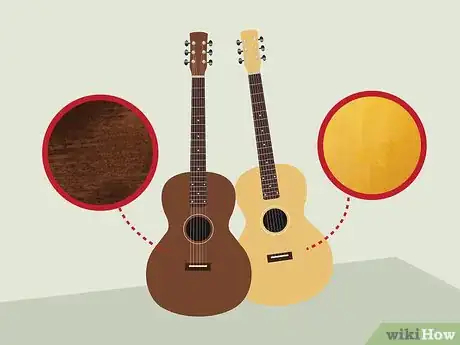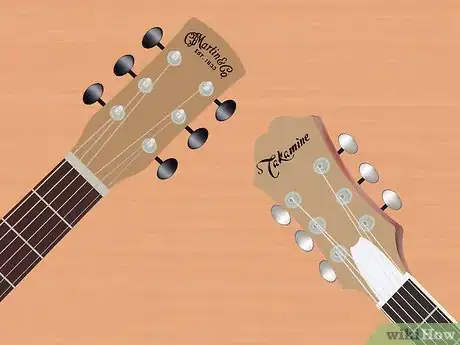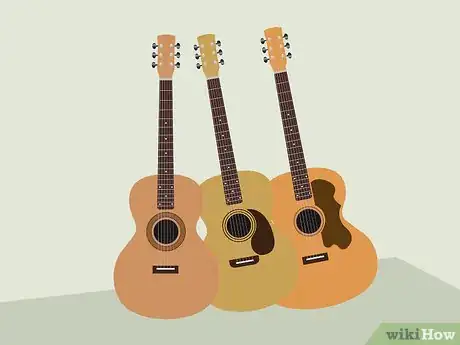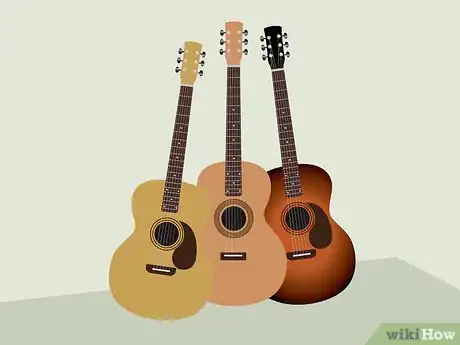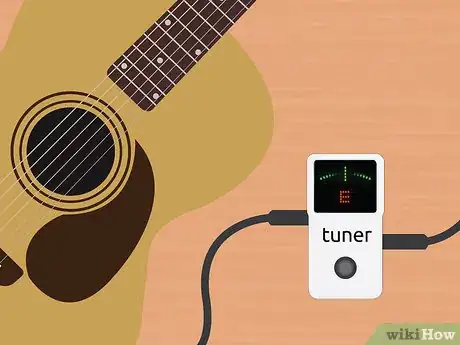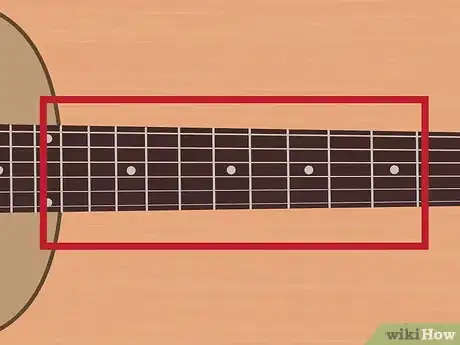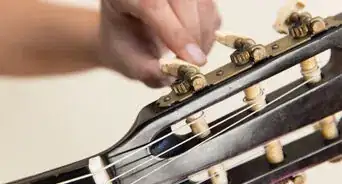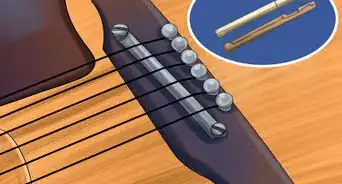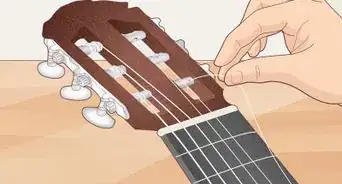This article was co-authored by Carlos Alonzo Rivera, MA. Carlos Alonzo Rivera is a guitarist, composer, and educator based in San Francisco, California. He holds a Bachelor of Arts degree in Music from California State University, Chico, as well as a Master of Music degree in Classical Guitar Performance from the San Francisco Conservatory of Music. Carlos specializes in the following genres: classical, jazz. rock, metal and blues.
wikiHow marks an article as reader-approved once it receives enough positive feedback. In this case, 97% of readers who voted found the article helpful, earning it our reader-approved status.
This article has been viewed 38,944 times.
Want to buy an acoustic guitar? Overwhelmed by the number of options? Buying an acoustic guitar is an investment, so you'll want to do a little research before you jump in. There are a variety of factors that determine why one guitar sounds, feels, and plays differently from another. Understanding these factors is key when it comes to deciding what acoustic guitar you should buy.
Steps
Determining Your Price Range
-
1Asses your budget. Before you look into the differences between guitars of different price ranges, you have to decide how much you're willing to pay at most. Find your maximum and then work from there. Know that most people recommend not paying less than $300 for a new guitar, even if you're a beginner, as the quality will make it sound inferior and difficult to play.
- Of course if you can find a good deal on a used guitar, there might an exception to the $300 rule.
EXPERT TIPCarlos Alonzo Rivera is a guitarist, composer, and educator based in San Francisco, California. He holds a Bachelor of Arts degree in Music from California State University, Chico, as well as a Master of Music degree in Classical Guitar Performance from the San Francisco Conservatory of Music. Carlos specializes in the following genres: classical, jazz. rock, metal and blues.Professional Guitarist
 Carlos Alonzo Rivera, MA
Carlos Alonzo Rivera, MA
Professional GuitaristOur Expert Agrees: The first thing to think about is budget. If you're a beginner, brand names aren't as important. You don't need to buy a Martin or Taylor unless your budget has room for that. Instead, buy a normal student model like Yamaha. Make sure the playability is comfortable and that the guitar is in excellent condition.
-
2Choose between a laminate and solid wood top. If you're on a tight budget, an acoustic guitar with a laminate top might work for. They're cheaper than solid wood tops, but they don't vibrate as well. This means that the sound won't be as rich and the volume not as loud.[1]
- You can tell whether a guitar is a laminate top or solid wood top by feeling the top. Laminate tops will feel and look glossier and smoother than pure wood.
Advertisement -
3Consider your skill level. It's important to consider how much experience you have with guitar because it will help determine how much to spend. An amateur will expect to upgrade guitars eventually, and doesn't have much need for the subtle aspects that make a high-end guitar better than a budget guitar. If you're more experienced with the guitar, you'll want to aim for something in the $700-$1200 range. If you're a pro, something in the $1200-$2500 range will last you a lifetime.
-
4Look into some of the best brands for each price point. Most well-known guitar brands have models for every price point, but some brands do certain price points better. Some brands to look into includes Fender, Yamaha, Epiphone, Takamine, Washburn, Taylor, and Martin.[2]
- Fender and Yamaha both make several models of acoustic guitars that are rated highly for beginners on a budget.
- Washburn, Epiphone, and Takamine all make great acoustic guitars for those with a little higher budget. These are great brands for intermediate players.
- Taylor and Martin make many high-end acoustic guitars. These guitars will be more expensive but for good reason.
Choosing a Shape and Style
-
1Decide if you want an acoustic or an acoustic-electric guitar. Acoustic-electric guitars have electronics in them that allow them to be plugged into amplifiers. Non-electric acoustic guitars need to be rigged with a microphone accessory or played into a microphone in order to be amplified or recorded. Acoustic-electric guitars are often more expensive than their acoustic counterparts, but if you'll often be playing in a band or in live settings to an audience, it's something to consider.[3]
- Acoustic-electric guitars often have a built-in tuner as well, which many people find useful.
-
2Pick a body style that works for. There are three basic body styles: Classic, dreadnaught, and jumbo.[4]
- Classic style guitars are often used for classical guitar playing. Guitarists who do a lot of finger picking sometimes prefer them because they have a lot of clarity and balance between the highs mids and lows.
- Dreadnaught guitars project more than classic guitars. Some describe them as boomy sounding. This is the most commonly played type of acoustic guitars for singer-songwriters, folk artists, and rock artists.
- Jumbo guitars are kind of like a cross between the shape and quality of classic guitars and the size and loudness of dreadnaught guitars.
-
3Get a travel or mini-acoustic guitar if you'll be traveling often or have small hands. There are many possible reasons you might want to look at travel or mini-acoustic guitars. If you're shopping for a child, a regular sized guitar might be too big. If you have smaller hands and find it difficult to make chord shapes on most guitars, travel and mini-acoustic guitars might be for you.[5]
Making the Final Choice
-
1Bring someone who can play the guitar if you don't know how. If you're a beginner to playing guitar, you might want to consider bringing a friend along to the store. Especially if you're buying a used guitar, a friend who has some experience with guitars will help you make a good decision.
- If you don't have a friend knowledgeable in guitars with you when you go to the store, you can also ask someone who works at the store for help. The people working at the music shop will likely have a wealth of information on guitars and can help you find a guitar that's right for you.
-
2Consider the differences in tone of different wood types. The type of wood that the guitar is made out of will affect how it sounds. Knowing what you want out of your guitar's tone will help you make a decision because then you can look for the wood type that best suites you. Some of the common wood types are:[6]
- Spruce is the most common type of material for acoustic guitars. It has a bright tone and remains clear even when played loudly.
- Cedar is favored by finger pickers because it delivers warm, rich tones that work well with fast picking.
- Mahogany has a strong sound that some describe as punchy. It is often used by blues players.
- Maple is very transparent and doesn't color the tone of the strings very much.
- Rosewood has an overall darker tone, with rich highs and mids and strong lows.
-
3Play the guitar. Ultimately, it will be difficult to decide whether a guitar is right for you without playing it a while. This is why shopping in person is preferable to online shopping. Most guitar store owners understand this, and they will allow you to play any guitar you're interested in.[7]
-
4Check some of the important quality aspects of the guitar. There are many factors to look at when inspecting a guitar. Of course overall comfortability and how it sounds to you are important, but look for some of these things as well:
- Knock on the guitar's body. An echoing sound usually means it will have greater bass, if a less echoing sound is produced it will normally sound bright.
- Check the action height. This is how far the strings are from the fretboard. The higher the action, the more difficult it will be to play. Look for a guitar with low, even action.
- Check the intonation. This means how well the guitar is tuned up and down the neck. Check this by playing an open D chord and then the same chord on the 14th fret. If it sounds out of tune, there may be a problem.
-
5Check for damage if you're going with a used guitar. Buying a used acoustic guitar is a great way to find a balance between quality and price. But if you do buy used, you should spend some extra time inspecting the guitar before you buy it. The first thing you should do is look for any obvious signs of damage on the body and neck. Small cracks and chips are okay, big ones are not.[8] [9]
- Play every note on the fretboard and listen for rattling or dead spots. Rattling could be sign that the bridge is loose and dead spots could be sign that the fretboard needs work.
- Look at the neck from the side. It should be practically straight. A little bowing is okay, but a lot is not.
- Where the neck connects with the body should be flush, and if you push gently on the neck, it shouldn't give at all.
- Gently push down on the body, all around. Listen for creaking, which could be a sign that the glue on the braces inside the guitar is loose.
Warnings
- Never buy a guitar without listening to it first.⧼thumbs_response⧽
References
- ↑ http://thehub.musiciansfriend.com/guitar-buying-guides/budgets-bouts-and-body-styles-the-acoustic-guitar-buyer-s-guide
- ↑ http://www.guitarsite.com/best-acoustic-guitar/
- ↑ http://thehub.musiciansfriend.com/guitar-buying-guides/budgets-bouts-and-body-styles-the-acoustic-guitar-buyer-s-guide
- ↑ http://www.guitarfriendly.net/acoustic-guitar-buying-guide/
- ↑ http://thehub.musiciansfriend.com/guitar-buying-guides/budgets-bouts-and-body-styles-the-acoustic-guitar-buyer-s-guide
- ↑ http://www.sweetwater.com/insync/acoustic-guitar-buying-guide/
- ↑ http://www.guitarfriendly.net/acoustic-guitar-buying-guide/
- ↑ http://www.guitarnoise.com/lessons/how-to-buy-a-used-acoustic-guitar/
- ↑ http://www.ebay.com/gds/What-to-Look-for-in-a-Used-Acoustic-Guitar-/10000000177635436/g.html
About This Article
To choose an acoustic guitar, go with a laminate top over a wood top if you're on a tight budget since laminate top guitars are cheaper. Also, if you'll be playing in a band or in front of live audiences, you may want to get an acoustic-electric guitar since they can be plugged into amplifiers. Otherwise, stick with a regular acoustic guitar to save money. You should also choose a guitar shape based on how you want your guitar to sound. For a classical sound, go with a classic body style. If you want a guitar that projects sound, try a dreadnaught style. To learn how to inspect and test out an acoustic guitar before buying it, scroll down!

